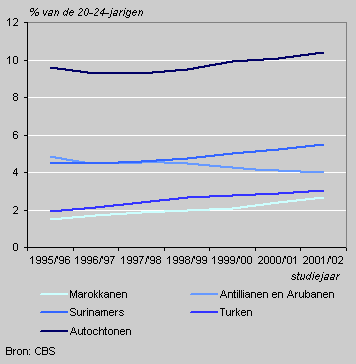More non-western foreigners in higher education

The participation of foreigners with a non-western background in higher education rose substantially in the period 1995/’96 – 2001/’02. The proportion of Turks and Moroccans enrolled at vocational colleges and universities doubled, that among Surinamese was one and a half times as high. The percentage of Antilleans and Arubans in higher education fell slightly in this period.
Percentage of vocational college students by ethnic origin

More non-western foreigners at vocational college
In 2001/’02 19 percent of native Dutch people aged 19-23 years were enrolled full-time at a vocational college. For non-western foreigners this was 9 percent. However, the increase for this group was substantial: in 1995/’96 only 5 percent attended vocational college.
Twice as many Turks and Moroccans
The increase among the percentages of Turks and Moroccans who attend vocational colleges was remarkably substantial. For both groups, the proportion among 19-23 year-olds rose by 5 percent points to about 8 percent.
More people with a Surinamese background, too, are attending vocational college. The proportion of this group rose from 7 percent in study year 1995/’96 to 12 percent in 2001/’02. After an initial increase, the proportion of young people with an Antillean or Aruban background at vocational colleges fell to 7 percent.
Relatively many western foreigners go to university
The proportion of native Dutch people aged 20-24 years at university was just over 10 percent in 2001/’02. For foreigners with a western background in the Netherlands, this was only slightly lower at 9 percent. Non-western foreigners lag further behind: in spite of an increase between 1995/’96 and 2001/’02, the percentage is less than half that of the native Dutch in this age group.
Fewer university students among Antilleans and Arubans
The proportion of Surinamese people going to university rose to 6 percent in 2001/’02. Far fewer Turks and Moroccans attend university. Even though the increase was relatively strong, the proportion remains under 3 percent. The percentage of Antilleans and Arubans fell from 5 percent in 1995/’96 to 4 percent in 2001/’02.
Percentage of university students by ethnic origin

Second generation non-western foreigners
The increase in the percentages of people with a non-western foreign background enrolled at university and vocational colleges is largely attributable to the second generation. One of the reasons is that the second generation accounts for an increasing proportion of people with a non-western background. In addition second generation foreigners are three times as likely to be in higher education than the first generation. This results in an increasing proportion of the total non-western foreigners in higher education.
Esther van Kralingen